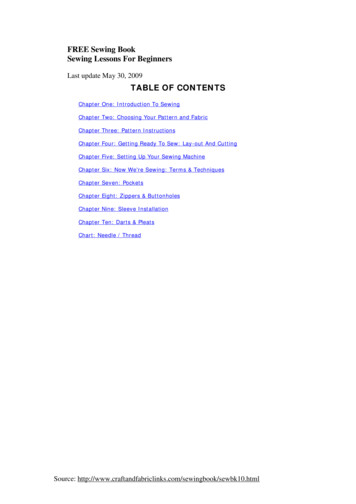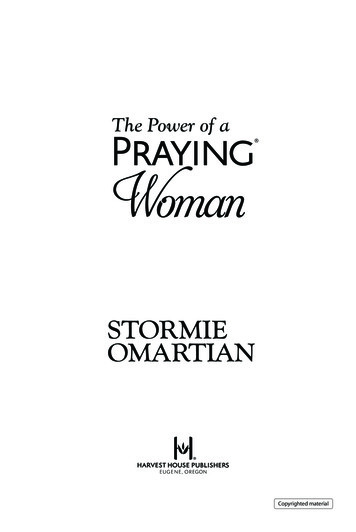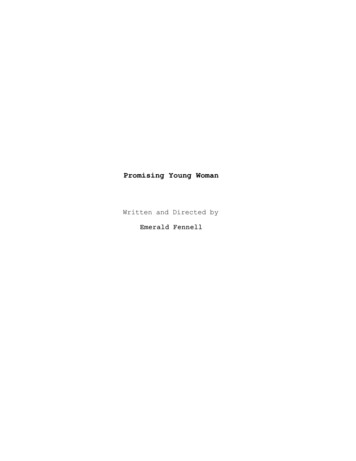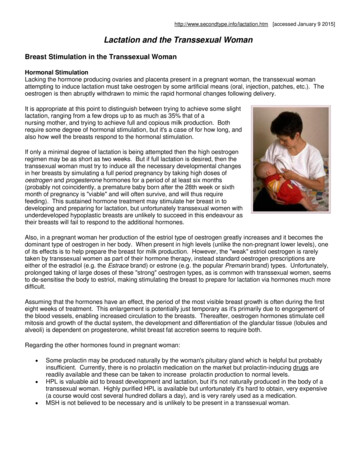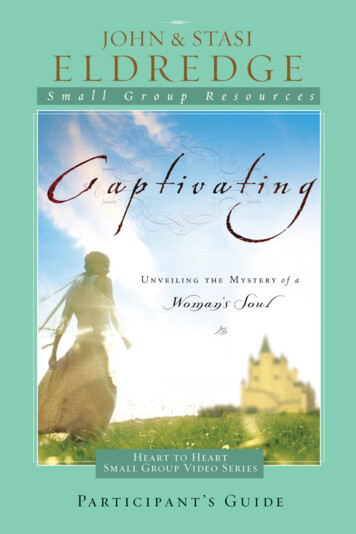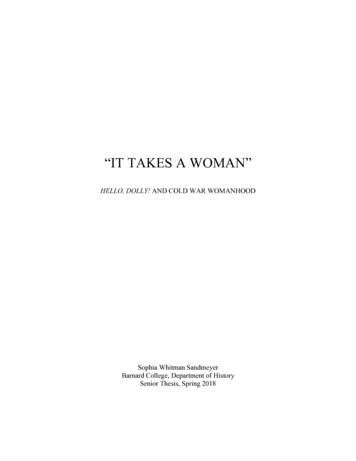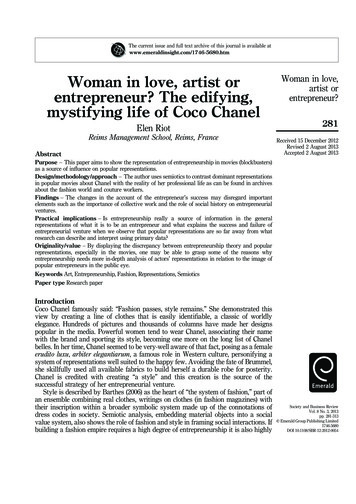
Transcription
The current issue and full text archive of this journal is available atwww.emeraldinsight.com/1746-5680.htmWoman in love, artist orentrepreneur? The edifying,mystifying life of Coco ChanelElen RiotReims Management School, Reims, FranceAbstractWoman in love,artist orentrepreneur?281Received 15 December 2012Revised 2 August 2013Accepted 2 August 2013Purpose – This paper aims to show the representation of entrepreneurship in movies (blockbusters)as a source of influence on popular representations.Design/methodology/approach – The author uses semiotics to contrast dominant representationsin popular movies about Chanel with the reality of her professional life as can be found in archivesabout the fashion world and couture workers.Findings – The changes in the account of the entrepreneur’s success may disregard importantelements such as the importance of collective work and the role of social history on entrepreneurialventures.Practical implications – Is entrepreneurship really a source of information in the generalrepresentations of what it is to be an entrepreneur and what explains the success and failure ofentrepreneurial venture when we observe that popular representations are so far away from whatresearch can describe and interpret using primary data?Originality/value – By displaying the discrepancy between entrepreneurship theory and popularrepresentations, especially in the movies, one may be able to grasp some of the reasons whyentrepreneurship needs more in-depth analysis of actors’ representations in relation to the image ofpopular entrepreneurs in the public eye.Keywords Art, Entrepreneurship, Fashion, Representations, SemioticsPaper type Research paperIntroductionCoco Chanel famously said: “Fashion passes, style remains.” She demonstrated thisview by creating a line of clothes that is easily identifiable, a classic of worldlyelegance. Hundreds of pictures and thousands of columns have made her designspopular in the media. Powerful women tend to wear Chanel, associating their namewith the brand and sporting its style, becoming one more on the long list of Chanelbelles. In her time, Chanel seemed to be very-well aware of that fact, posing as a femaleerudito luxu, arbiter elegantiarum, a famous role in Western culture, personifying asystem of representations well suited to the happy few. Avoiding the fate of Brummel,she skillfully used all available fabrics to build herself a durable robe for posterity.Chanel is credited with creating “a style” and this creation is the source of thesuccessful strategy of her entrepreneurial venture.Style is described by Barthes (2006) as the heart of “the system of fashion,” part ofan ensemble combining real clothes, writings on clothes (in fashion magazines) withtheir inscription within a broader symbolic system made up of the connotations ofdress codes in society. Semiotic analysis, embedding material objects into a socialvalue system, also shows the role of fashion and style in framing social interactions. Ifbuilding a fashion empire requires a high degree of entrepreneurship it is also highlySociety and Business ReviewVol. 8 No. 3, 2013pp. 281-313q Emerald Group Publishing Limited1746-5680DOI 10.1108/SBR-12-2012-0054
SBR8,3282specific in that most choices include an aesthetic dimension. What seems to be missinghere, however, are the concrete work practices that unify the entrepreneurial venturewith its artistic vision.Recently, new approaches to entrepreneurship (Hjorth and Steyaert, 2009) haveencouraged combining different views, among them semiotics and textual exegesis, tolook at all kinds of ventures. Different kinds of stories (Hjorth, 2004a, b) should makeentrepreneurship projects richer than mere business plans; yet, in many ways it is aterritory that is quite alien to aesthetics because of this system of values. What peoplestill associate with entrepreneurship is economic performance. So, what is interestingabout entrepreneurship in relation to aesthetics is that it relates the materiality ofproductive work system to various layers of representations associated with the figureof the entrepreneur or the nature of the transaction.Going back to Barthes, we suggest that this new avenue for research, looking at theaesthetics of entrepreneurship, may be explored in the fashion industry to learn moreabout the nature of value creation and value in general. Fashion ventures are associatedwith creativity and entrepreneurship. In an age where creative industries are oftenpresented as one of the most promising sources of entrepreneurial ventures andinnovation, there is an urgent need to describe and interpret this “creative” phenomenonand in particular, how art and economic values can coexist. To do so, one should examinethe creative, artistic nature of value creation in entrepreneurship, but should alsoanalyze how values shape and legitimize a vision, that of a creator, involving otherpeople at work. Then one should look at its trace as a collective memory. In our view, thiscreation and its transmission have so far remained almost entirely unexplored, possiblybecause collective memory does not seem to link art and style with productive work. Weexplore this question by using a specific example.In this paper, we take the case of Coco Chanel as a real-life character who became aninspiration for a movie character. Three biopics have recently been released, and havehad considerable success. At the heart of each movie is Coco’s passion for fashion. Thispassion is related to the revelation of a unique gift for art and its public recognition.Despite many differences, all the movies build a representation that corresponds to theideal figure of the entrepreneur as a self-made (wo)man. However, I believe there ismore to reality than what success stories reveal. In line with Barthes, semiotics mayprove helpful here to deal with this symbol of fashion success.In an attempt to “bring work back in” (Barley and Kunda, 2001) and to look beyondthe story-telling and imagery of entrepreneurial myth-making, we explore Coco Chanel’swork and life. According to André Malraux, the “Empress of Fashion” was said to be oneof the three figures (together with De Gaulle and Picasso) that the world wouldremember about twentieth century France. She was one of the Times’ 100 personalitiesof the twentieth century. Celebrating the woman behind the brand, in 2008 and 2009,three successful biographical movies portrayed Coco Chanel. We use these three movies,contrasting them with biographies and historical accounts, to describe and interpret thedominant representations of a successful female entrepreneur. Despite different stylisticchoices, all the stories seem to agree in portraying the heroic figure of a self-made womanwho created a fashion empire at the cost of her personal life. We interpret these choicesusing semiotics and textual analysis to complement three more traditional approaches:entrepreneurship, feminist studies and narrative approaches. The goal is to analyze theinfluence of everyday life clichés on these approaches.
More specifically, in contrast with the popular story that the movies and the brandweb site convey, we point out three missing dimensions behind the Coromandel[1]screens of sentimentality, artistic friendship and feminine solidarity: business dealsbased on personal contacts, working conditions in haute couture and the fashionindustry and the importance of public image and its codes in women’s life as part of the“tournaments of value” (Appadurai, 1986) of modern times. This raises question aboutthe role that aesthetics should play in telling us more about entrepreneurial ventures,work and society.I. Questioning the traditional figure of the entrepreneurMany aspects of the entrepreneurial phenomenon have been explored in relation to atheory of action. In contrast with more set traditions such as economics, psychology andsociology, aesthetics brings to life different aspects that may have been overlooked andin that regard, biopics prove interesting in their visual approach to entrepreneurship.However, in my view, the aesthetic view of entrepreneurship helps us pay more attentionto the way representations are constructed (1) and to the implicit range of skills required,which may help demonstrate the ability of certain kinds of people to undertakeentrepreneurial ventures (for instance women) because of their knowledge and ability inaesthetics (2). Finally, aesthetics may be related to story-telling and the impressionmanagement accomplished by telling a pleasant tale (3). However, by uncovering theinfluence of aesthetics in shaping our view of entrepreneurship, we must also be aware ofour own technique in using aesthetics to look at entrepreneurship. With no clearlyexposed method, the anesthetization of entrepreneurial ventures may come with a heavyprice.1. The aesthetic side of entrepreneurshipPointing out the aesthetic side of entrepreneurship is a way of insisting on the creativenature of new ventures. It moves away from more traditional approaches, which wouldtend to focus on business models and entrepreneurial figures to uncover implicitrepresentations in relation to values.For instance, both Schumpeter (1934, 1944, 1991) and Drucker (1985) point out thestory and the actors behind the entrepreneurial project. The plot is one of “creativedestruction” and the exploitation of a market opportunity. Although the stage has beenset for a specific type of plot, it may need to evolve and include other types of actorsand plots. Whether one talks about barefoot entrepreneurs (Imas et al., 2012) who striveto survive or about marginalized women, the story becomes enriched with more thanjust the challenge of obtaining funds and finding clients. The entrepreneurial projectcreates a tension between their different social roles (at work and at home, in theirsociety and outside) and it may involve cultural changes (Guerrier, 2004; Gherardi,1995) so as to express different value systems. Aesthetics allows us to look at thecontradictions inherent to entrepreneurship without necessarily considering them aproblem in the first place.For instance, remembering de Certeau (1997) and his criticism of frozenrepresentations in discourse, may encourage us to take a more practice-orientedview of entrepreneurship looking at it as a form of everyday bricolage. The position ofthe entrepreneurial venture in its specific time and space, its intentions in relation to itslocation should be read as a genealogy of values. This would involve challenging theWoman in love,artist orentrepreneur?283
SBR8,3ready-made tales (often combined with such artifacts as PowerPoint slideshows androad-show business plans) by paying more attention to the actual performance of theentrepreneurial venture This in turn may provide more information about the realprofiles of entrepreneurs (Steyaert and Hjorth, 2006) and include a greater variety ofprofiles and skills. Two related ways of identifying specific differences, involvingaesthetics, are feminist studies and narrative approaches.2842. A bigger picture for the entrepreneurial profileOne very good example of aesthetics in relation to the performativity of the role and theimportance of the voice and the body is the case of women entrepreneurs of Moroccanorigin in The Netherlands (Essers and Benschop, 2007). Reflecting about this experienceas a researcher, one of the field-workers (Ellis, 2009) was able to capture traits of thewoman entrepreneur that are often missed if one is only considering her as a silencedvoice. In her efforts to impose herself in a world so far dominated by men, she is both in aposition of inferiority compared with masculine professionals (Ortner, 1974) and, as anentrepreneur taking charge, in a position to play the part of the “phallic woman” (Butler,2000; McRobbie, 2009) in particular towards other men and women who are interactingwith her as employees. In that regard, power issues between co-workers at work,between communities (at work, at home and in the public space) can be as complex asgender issues and one should not be dis-embedded from the others and given priority.Using aesthetics could be a way to justify the specific power relations some womenimpose upon others, but it can also be a way to introduce more socio-material dimensionsand to situate interactions in time and space. This makes a more varied range of stories.3. Stories about entrepreneurs: looking at the making-ofWorking on entrepreneurs, both Czarniawska-Joerges (1997, 1998) and Gartner (2007)pointed at the importance of narration to better understand meaning through the waystories are composed. It seems that, although their approach to story-telling is different,both authors think that having different tales and different styles is important if we areto go beyond the stereotypes and myths introduced by representations. Although thisis the reason why social analyses diverged from arts in the first place (Nelson et al.,2000), one may nevertheless use text analysis and exegesis to show that, in some of therepresentations commonly taken for granted in management and in particular, inentrepreneurship, one may still find a great deal of the stylizations and clichés thatappeal to lovers of romance and kitsch.This can be especially true in creative industries and fashion, where so much of theprestige and reputation of the products and services is related to their image. Skillfuland stylish story-telling is compulsory to the point of being part of the brand.Admitting that stories are (at least partly) fashioned for this effect, we may also betteridentify the role of aesthetics in relation to power issues. Since, as pointed-out byLounsbury and Glynn (2001), stories are part of impression management and help definevalue during a road show, they are addressed towards an audience and they are meant toconvey a specific message. However, the relationships between past events, theprojected future and ongoing implement
Coco Chanel famously said: “Fashion passes, style remains.” She demonstrated this view by creating a line of clothes that is easily identifiable, a classic of worldly elegance. Hundreds of pictures and thousands of columns have made her designs popular in the media. Powerful women tend to wear Chanel, associating their name


